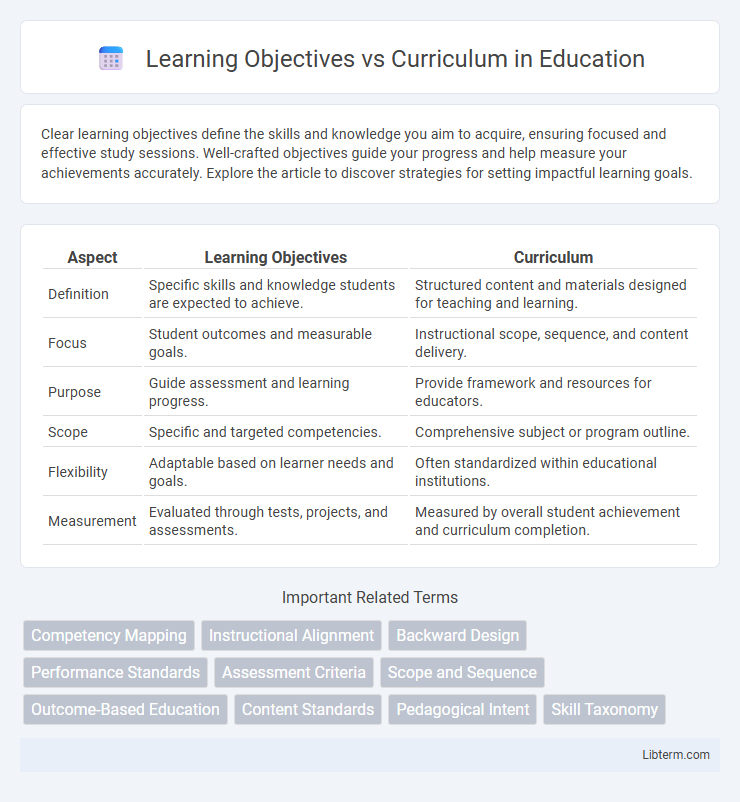Clear learning objectives define the skills and knowledge you aim to acquire, ensuring focused and effective study sessions. Well-crafted objectives guide your progress and help measure your achievements accurately. Explore the article to discover strategies for setting impactful learning goals.
Table of Comparison
| Aspect | Learning Objectives | Curriculum |
|---|---|---|
| Definition | Specific skills and knowledge students are expected to achieve. | Structured content and materials designed for teaching and learning. |
| Focus | Student outcomes and measurable goals. | Instructional scope, sequence, and content delivery. |
| Purpose | Guide assessment and learning progress. | Provide framework and resources for educators. |
| Scope | Specific and targeted competencies. | Comprehensive subject or program outline. |
| Flexibility | Adaptable based on learner needs and goals. | Often standardized within educational institutions. |
| Measurement | Evaluated through tests, projects, and assessments. | Measured by overall student achievement and curriculum completion. |
Understanding Learning Objectives: Definition and Purpose
Learning objectives are specific, measurable statements defining what learners should know or be able to do after instruction, serving as clear targets for both teaching and assessment. Unlike a curriculum, which outlines the overall content and structure of a course or program, learning objectives focus on the intended outcomes of individual lessons or units. Effective learning objectives guide instructional strategies, enhance student engagement, and provide criteria for evaluating academic progress.
Defining Curriculum: Scope and Components
Curriculum encompasses the comprehensive scope of educational content, including learning objectives, instructional materials, assessments, and teaching strategies. It defines the framework for what is taught, how it is taught, and the expected outcomes, ensuring alignment between educational goals and classroom activities. The components of curriculum integrate cognitive, affective, and psychomotor domains to provide a holistic learning experience tailored to student needs and educational standards.
Key Differences Between Learning Objectives and Curriculum
Learning objectives define specific, measurable skills or knowledge students are expected to achieve, while curriculum encompasses the comprehensive plan, including content, materials, and instructional methods designed to facilitate learning. Learning objectives provide clear targets for assessment, ensuring alignment with desired outcomes, whereas curriculum outlines the broader educational framework and pacing. The key difference lies in learning objectives focusing on individual competencies, and curriculum addressing the overall educational experience and scope.
The Role of Learning Objectives in Instructional Design
Learning objectives serve as precise, measurable targets that guide instructional design by defining what learners should achieve after instruction. They align content, activities, and assessments within the curriculum, ensuring cohesive and goal-oriented learning experiences. Clear learning objectives enhance instructional effectiveness by providing a framework for evaluating student progress and improving overall curriculum design.
How Curriculum Shapes the Educational Experience
Curriculum defines the structured framework and content delivered in educational settings, directly shaping the learning objectives by specifying the knowledge and skills students must acquire. It influences the educational experience by outlining the scope, sequence, and assessment methods that guide instruction and student engagement. This alignment ensures that learning objectives are measurable, relevant, and tailored to meet academic standards and student needs.
Aligning Learning Objectives with Curriculum Development
Aligning learning objectives with curriculum development ensures that instructional content directly supports desired educational outcomes, fostering coherence and purpose in teaching. Clearly defined objectives guide the selection of materials, assessments, and teaching strategies, promoting measurable progress and skill acquisition. This alignment enhances curriculum relevance, maximizes student engagement, and streamlines evaluation processes for educational effectiveness.
Assessment Strategies: Measuring Objectives vs Evaluating Curriculum
Assessment strategies for learning objectives emphasize precise measurement of specific skills and knowledge through quizzes, tests, and performance tasks directly aligned with stated objectives. In contrast, evaluating curriculum involves broader methods such as curriculum mapping, student feedback, and longitudinal studies to assess overall program effectiveness and skill progression. Effective education requires integrating both approaches to ensure individual learning goals are met while maintaining curriculum quality and coherence.
Benefits of Clearly Defined Learning Objectives
Clearly defined learning objectives provide measurable targets that enhance student engagement and improve knowledge retention by focusing instruction on specific skills and outcomes. They enable educators to align curriculum content, assessments, and teaching strategies effectively, ensuring coherent and goal-oriented learning experiences. This clarity supports personalized learning paths and facilitates accurate evaluation of student progress and curriculum effectiveness.
Challenges in Integrating Objectives into Curriculum Planning
Integrating learning objectives into curriculum planning presents challenges such as aligning diverse educational standards with specific learning goals and ensuring coherence across multiple subjects. Educators struggle with balancing broad curriculum requirements while customizing objectives to meet varied student needs and assessment criteria. Effective integration demands continuous collaboration, clear communication, and ongoing evaluation to maintain curriculum relevance and instructional effectiveness.
Best Practices for Balancing Learning Objectives and Curriculum
Effective balancing of learning objectives and curriculum requires aligning clear, measurable objectives with the content scope to ensure targeted skill development and knowledge acquisition. Best practices include continuously reviewing and adjusting the curriculum to reflect evolving learning goals, integrating formative assessments to monitor progress, and fostering instructional flexibility to address diverse learner needs while maintaining curriculum standards. Emphasizing learner-centered design and data-driven decisions enhances coherence and supports meaningful educational outcomes.
Learning Objectives Infographic

 libterm.com
libterm.com